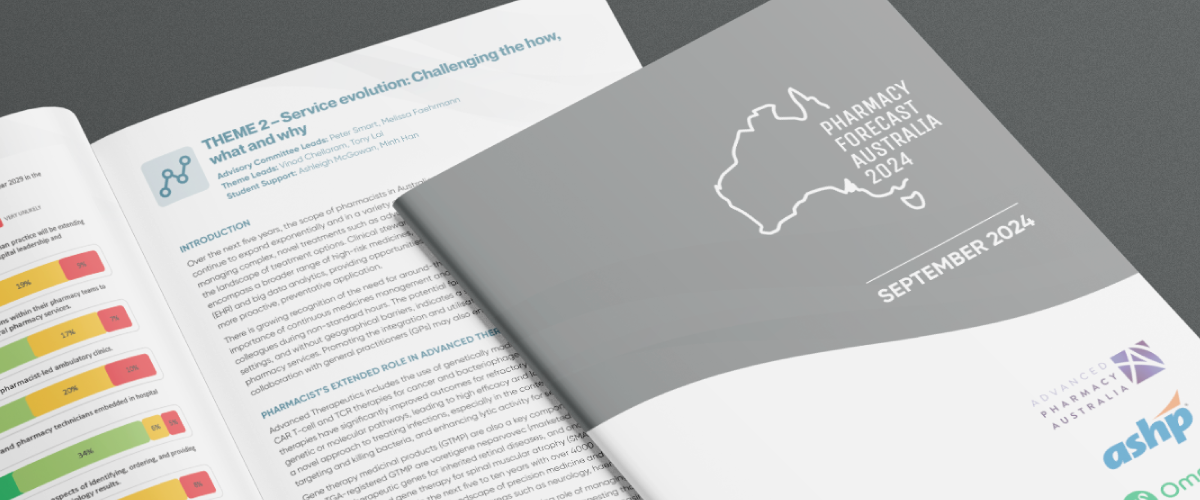Mon 9 September 2024
Forecasting the future impact of an expanding hospital pharmacy workforce
Advanced Pharmacy Australia (AdPha) released the latest edition of Pharmacy Forecast Australia at Parliament House in Canberra today, covering key themes impacting the near-future of pharmacy and its workforce including education, sustainability, AI and digital governance.
The annual thought-leadership piece checking the pulse of hospital pharmacy leaders across Australia produced 39 recommendations this year, to guide the strategic planning of pharmacy practice in hospitals and adjacent care settings over the next five years.
AdPha President Tom Simpson says a dominant message arising from the survey and analysis was how empowering pharmacist-led innovation can improve patient outcomes and close gaps in care continuity while improving the efficiency of the health system.
'We’re proud to release Pharmacy Forecast 2024, to spark debate and shape strategic planning. Amid the 38 data points were both encouraging and concerning signals, extrapolated into recommendations by leaders of our profession.
'These include integrating traceability data to reduce medicine wastage and cost; removing regulatory barriers and reprioritising funding to expedite use of advanced therapeutics; expanding pharmacist-led outpatient clinics to enable pharmacists to modify medicines; and expanding virtual care models for high-risk patients while increasing funding for care of high-risk patients within hospital catchments.
'These are proven approaches in pockets of the country that can benefit patients and our health system when scaled up, and when led by practitioners who are trained, equipped and recognised for their contributions.
'There was also strong positivity around embedding partnered pharmacist prescribing in more hospitals, a fundamental recommendation of AdPha’s Position Statement on Medication Safety, and we look forward to supporting progress on non-medical prescribing discussed in the current Scope of Practice review.’
Mr Simpson thanked organisations who contextualised the 2024 data with commentary through ‘Partner Perspectives’: the Australian Pharmacy Council, Australian Medical Association, Australian Alliance for Artificial Intelligence in Healthcare, National Rural Health Alliance and the National Aboriginal Community Controlled Health Organisation as well as The Hon Ged Kearney MP, Assistant Minister for Health and Aged Care.
Other key recommendations in this year’s report include:
- Pharmacy leaders must be embedded in digital governance to streamline processes and optimise operational performance.
- A nationally coordinated response strategy is required to address the unsustainability of medication supply resulting from drug shortages and discontinuations.
- A shift in the education journey in Australian pharmacy is needed to deliver the skills and support that will sustain the future pharmacy workforce.
- Collaborative team-based pharmacist prescribing should be extended to independent pharmacist prescribing in hospitals to shorten length of stay and improve care outcomes.
The 2024 edition is the first Forecast launched under the new trading name of Advanced Pharmacy Australia; AdPha Chief Executive Kristin Michaels says the new branding provides a broader remit for hospital pharmacy advocacy.
‘Hospital pharmacy is the fastest-growing pharmacy sector in Australia, currently comprising 25% of all pharmacy jobs. ‘We know this figure is likely higher as hospital pharmacy practice has, for many years, thrived beyond its traditional boundaries of the hospital building. ‘As Advanced Pharmacy Australia, we represent hospital-based pharmacists and technicians, as well as practitioners working at all levels of practice in advanced pharmacy, providing hospital-informed or hospital-led care in transitions of care, aged care, general practice, as well as telehealth and virtual health. ‘As it has been for more than 80 years, our mission remains to support pharmacists and technicians to deliver the best and safest care, collaboratively with their pharmacy and healthcare peers, in the places where medicines risks are highest.’


